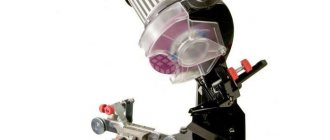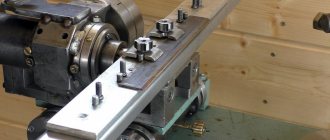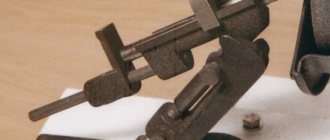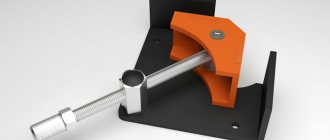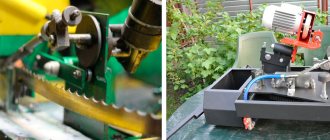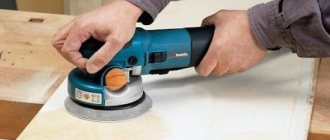Any cutting tool tends to become dull during use. This also applies to carbide saw blades, which must be sharpened regularly in order for wood to be sawed quickly and efficiently.
The easiest way to sharpen teeth on a circular saw is to use a regular file. But when working with your own hands, to bring the cutting tool into working condition, many difficulties arise that only a good specialist with sufficient experience can cope with. It is much easier, faster and more efficient to use a homemade machine for sharpening circular saws or a sharpening machine for circular knives for this operation.
Machine for sharpening circular saws Monolit TD1-600
If you have a homemade electric sharpening machine for circular saws, regardless of whether it is a factory tool or a homemade one, you should know the basic principles of using such equipment. Especially when there is a need to sharpen the teeth of saw blades that have different geometries and sharpening angles.
Machine
A machine for sharpening circular saws is not just one device. This can be called a large group of equipment and tools for special purposes.
– Automatic. The sharpening process is completely mechanized and there is no need for human participation. Such devices are used for production purposes.
- Manual. These can be any devices and tools for sharpening by hand. The productivity of such equipment is much lower than automatic machines. This type has found application in handicraft workshops for domestic needs.
Equipment of this kind is available for sale in a wide range; devices may differ in function, power and price. A manual machine for sharpening circular saws, the price of which will be much lower (about 20 thousand rubles), can be made independently. The equipment consists of dense and hard alloy plates that serve as cutters.
Plates for them are made from alloys of various compositions.
Design and principle of operation
The machines structurally consist of the following components:
- a frame on which all structural elements are fixed;
- a disc holder designed for their installation and fixation relative to the grinding disc;
- electric motor with a special mount for an abrasive wheel;
- governing bodies;
- angular position regulators;
- rulers to determine the pressure during processing.
When sharpening, the saw blades with the grinding wheel move, but the motor remains in place. Therefore, during installation, it is important to ensure a stable position of the equipment that is resistant to vibrations and loads.
The sharpening equipment has the following operating principle:
- The disk is mounted on a special conical clamp of the machine.
- Its position relative to the horizontal is set using a protractor to the required bevel of the teeth.
- The starting tooth is marked with a marker.
- The machine turns on.
- Sequential turning is performed.
- After sharpening is completed, the surface quality is checked and test cutting is performed.
Differences in insert teeth
The tooth of hard alloys has four main planes for work: front, back and lateral (auxiliary). When the planes intersect with each other, cutting edges are formed: the main one and a pair of auxiliary ones.
The shape of the teeth is as follows:
- Direct. The use of this form will be justified when longitudinal cutting is required, which is quick in time and not required in quality.
– Oblique or beveled. The angle of inclination of the rear shape can be right or left, they alternate with each other. This configuration is the most common. Sharpening blades of different sizes are used to work with different materials in any direction.
– Trapezoidal. This tooth dulls its edges more slowly than a beveled tooth. Alternate it with the straight one. In this case, the rough cut was a longer trapezoidal cut, and the finishing cut was a short straight cut.
– Conical. This form of teeth performs a rough cut on the lower edge of the boards, while protecting the upper edge from chipping. Basically, the front edge of such an element is flat. But if you make it concave, then it is possible to use this device for cross cutting in a finishing version.
Read also: Thick foil for embossing
Sharpening angles
The fundamental angles are those determined by the shape of the teeth. These are front and rear, as well as bevel along the front and rear planes.
For longitudinal cutting of the front angle, it is recommended to set the degree in the range from 15 to 25. For transverse cutting - 5-10 degrees. For universal saws of both sections, it is more correct to choose the average value of 15 degrees.
The size of the angle is also determined by the hardness of the cutting material.
You can buy a machine for sharpening carbide circular saws at a cost of 15,000 rubles. You can also shell out for more expensive devices. For example, PP-480Z will cost its owner 280,000 rubles. Prices vary and depend on the purpose of the device, its functions, power and performance. For a small workshop or home use, you can purchase a JMY8-70 circular saw sharpening machine. Its cost is within 18,000 rubles.
Circular saw and means of sharpening it
You can sharpen a circular saw with a wheel made of silicon, CBN or diamond. The choice of wheel material depends on what the saw teeth are made of.
IMPORTANT TO KNOW: Assembling a sheet bending machine with your own hands
If the cutting blade of the saw is steel, then it is good to sharpen it using CBN wheels. But when a row of teeth is made of carbide, it is better sharpened by a silicon or diamond wheel.
Carbide cutters are sharpened at a wheel speed of about 18 meters per second.
This means that if a diamond wheel with a diameter of 12.5 cm is used, the engine must make more than 1500 revolutions per minute. Less hard alloys wear out more slowly.
By sharpening the saw blade on a machine, you can change the position of the saw blades relative to the grinding wheel using several methods.
Sometimes it is enough to move only the saw blade, sometimes only the motor and the wheel. But in some cases it is necessary to move both the saw and the diamond wheel simultaneously.
There is a wide variety of sharpening machines, they have different functions. Highly priced machines are equipped with a special program that controls automatic operation without personnel supervision.
Simple models are cheaper. They require the participation of a worker who must fix the saw so that it is at the desired sharpening angle.
Video:
All further operations are also carried out by hand. You will need to turn the saw around its axis, submit it for grinding and observe how much metal is removed from each tooth.
That’s why it’s better to work on a simple machine at home, when you need to sharpen dull saw blades from time to time.
The most basic device for sharpening saw blades includes two main components in its system. These components are a motor equipped with a wheel, and a support where the saw itself is placed.
In addition, the machine has a rotating mechanism that changes the angle of inclination of the saw blade. The screw of this system ensures the displacement of the saw along the axis of the sharpening wheel.
This operation sets the desired value for the sharpening angle at the front.
The screw also helps set the stopper in the required position, preventing the wheel from going too deep into the space between the teeth.
Sharpening rules
The main wear of saw teeth occurs on the top edge, which is directly involved in cutting. Its rounding can be 0.3 mm. The central face changes earlier than the others.
– We must not allow significant wear on the saw. The edge can be rounded no higher than 0.2 mm. It is more difficult to sharpen a saw that is duller than this value. This will take longer than for a tool with normal wear. The degree of wear is determined either by the type of cut or by the teeth.
– We must not forget about the maximum possible number of sharpenings performed. This value is in the range of 30-35 times. To achieve this result, both surfaces are treated at once.
– Before starting work, you should clean the working disk from dirt, and also measure the angles of inclination. Preparation for sharpening is carried out from the front of the tooth. The layer of metal that can be removed is 0.20 mm.
– If abrasive diamond wheels are used for sharpening, they must be cooled with a liquid of a special composition (coolant). For better quality and lower specific gravity, it is better to choose a high-grit wheel.
– Jagged edges and irregularities should not be allowed, even if this is a homemade machine for sharpening circular saws. They can lead to untimely exit from work and crumbling of the metal.
How to know when it's time to sharpen a disc
Cutting discs used for processing wood and wood-based materials experience wear and tear over time, reducing their productivity. To restore the effectiveness of the cutting tool, you will need to sharpen the teeth. You can find out that the teeth on the disk need to be sharpened by the following factors:
- To cut wood, it is necessary to apply force to press the tool against the workpiece being cut.
- There is smoke coming from under the protective casing.
- The protective casing becomes overheated
- There are signs of a burning smell. This means that the teeth do not saw the wood, but cut it
Using a faulty attachment on a power tool leads to a decrease in work productivity, and also increases the likelihood of early failure of the power tool and the attachment itself. A decrease in performance increases the load on the electric motor, which eventually begins to overheat and fails.
This is interesting!
It is irrational to work with a dull disk, since in addition to increasing the load on the power tool, the work time for sawing workpieces increases.
artisanal
Sharpening it yourself won’t be too difficult. Especially if you have the necessary equipment. And if not, then you can make it yourself. You can make a machine for sharpening circular saws, the price of which will only please you, from simple parts. To do this you will need the following basic elements:
The circle is fixed on the engine, the disk blade is on the caliper, the screws will ensure the movement of the workpiece along the axis of the circle, which will provide the desired angle.
The main task for such an element as a machine for sharpening circular saws is to fix them in the required position relative to the circle. This is necessary to accurately maintain the angles; this can be provided by a stand mounted on the machine frame in the same plane as the circle.
When placing the disk on a stand, the teeth must be perpendicular to the plane of the sawing machine.
Techniques and rules for turning saw blades on wood
To restore the condition of the saw teeth, it is necessary to sharpen their edges with high quality. In this case, it is necessary to take into account their uneven wear. Mostly the front part becomes dull because a lot of the load falls on it.
Before sharpening the cutting disc, you need to clean its surface from dust and dirt. Then you need to check it for chips and cracks. If these defects are identified, it is prohibited to continue using the damaged cutting tool.
Then you need to study in detail the manufacturer’s instructions for operating the machine. It is important to first prepare it (install it on a flat surface, connect and configure it correctly). Then you can move on to turning the discs, and the technology will depend on the type of teeth and the area being sharpened.
Sharpening a straight tooth along the front plane
The front part of the teeth of the saw blades is sharpened in this way:
- The disc to be sharpened is placed on the mandrel, after which it is clamped with a conical sleeve and nut.
- Then it is adjusted horizontally using a pendulum protractor. In this case, the bevel angle of the front plane should be equal to 0°.
- By rotating the screw, the mandrel with the wheel moves horizontally to precisely adjust the front sharpening angle, as a result, the front part of the tooth should be pressed tightly against the grinding wheel.
- The first tooth to be sharpened is marked with a marker.
- The electric motor is turned on, after which the front part of the tooth is sharpened - to do this, it is pressed against the abrasive wheel several times with translational movements and released. Moreover, due to the pressing force, the thickness of the metal removed from the tooth is regulated.
- After sharpening one tooth, the saw blade is removed from the grinding wheel, then it is rotated along the axis by one tooth for further sharpening.
- This procedure is repeated until the disc being sharpened rotates to the location previously marked with a marker.
Sharpening a front beveled tooth
To do this, the disk must be installed at an angle - at the bevel angle of the front part of the teeth. Most often it is +8°. Then the 1st tooth is also marked with a marker and every 2nd tooth is sharpened sequentially. Next, the position of the disk is changed and a negative sharpening angle of -8° is set. Then every second tooth of the disc is sharpened again.
During turning, it is necessary to maintain a uniform bevel for each cutting segment. If there is a large error, it is necessary to reinstall the disc being sharpened so that the teeth on it are of the same shape. In this case, it is necessary to periodically make control measurements.
Sharpening teeth on the back plane
One of the important stages of turning circular saw blades is processing the back of the teeth. To do this, they are installed so that the back of the teeth is located in the same plane with the working surface of the grinding wheel and is in normal contact with it.
It is also necessary to take into account the rotation speed of the working tool. On equipment with manual adjustment, it is necessary to eliminate the possible overheating of the edges of the teeth being sharpened. In addition, you need to make sure that the circle does not remove a lot of metal from the teeth. Changing the shape of one or more cutting elements will negatively affect the quality of wood processing.
Important! Regardless of the part of the teeth being sharpened, it is necessary to follow the dressing technology so that the saw cuts wood quickly and efficiently.
Exploitation
Before you start making this unit yourself, you need to think through the drawings of a machine for sharpening circular saws. You can calculate them yourself, or you can turn to a professional. In any case, in order to understand all the intricacies of the future device, you cannot do without a preliminary paper version. If you have the necessary knowledge, you can cope without turning to a specialist.
A machine for sharpening circular saws, created with your own hands, has a big advantage in terms of price over a factory unit. It also does not require any special skills to operate.
Sharpening without a machine
You can sharpen a saw at home without the help of a machine. But you shouldn’t hold it by hand while sharpening on a grinding wheel. For correct operation, hand effort will not be enough, and the eye will not be able to adjust the desired angle. To simplify the task, you can use some kind of fixation device; for this purpose, a regular flat delivery will be useful. The axis of the sharpening disk must coincide with the surface of the stand. And the circle, in turn, should be placed perpendicular to the saw. If it is necessary to make corners, the structure is made movable using hinges. But here the difficulty arises in maintaining the same angle of the front and rear sharpening. Rigid fixation of the saw wheel in relation to the abrasive disc will help to avoid this. This can be done by using an arbor groove or attaching stops in the stand, which will allow you to secure the corner.
Chainsaw chains and equipment for sharpening them
The chain area is not always well sharpened by a regular file. It will not help if the chainsaw has become very dull after plowing the ground with sand or gravel.
You will have to look for a device better than a file even when the cutting elements have been sharpened so much that they have completely lost their shape.
There is no way to do this without special equipment - a machine for saw blades.
This chain sharpening device can be either manual or electric, equipped with sharpening wheels.
The machine is almost no different from a bow saw, only the working part is not a saw blade, but a file in the shape of a long circle.
Using a machine, the chain is sharpened and guided so that the outer edges of its teeth are the same size.
The tooth that you need to focus on during the sharpening process is the smallest one. In order for the machine to correct the type of teeth correctly, it can be configured to the parameters required for this.
Video on sharpening discs:
It's easy and convenient to use an electric tool to sharpen your saw chain.
It has a settings panel where you can change functional modes, that is, position the chain at a certain angle and so that the disc evenly touches the edges of all teeth.
There is even a machine that has an automatic mechanism that clamps the chain like a vice.
The machine operates in the same way as a chain sharpening wheel and gauge. Only he makes more precise sharpening movements.
The mechanism must be brought to each tooth of the chain two or three times.
IMPORTANT TO KNOW: CNC milling and engraving machines for metal
When moving on to sharpening the next element, you cannot reset the settings or reset the sharpening mode. The remaining row of teeth must be sharpened in the same way as the very first control tooth.
With this approach, all pointed protrusions on the chain will not vary in size. When it comes to grinding down the stopper, you will need to use a flat tool instead of a circle file.
Types of teeth
The main cutting element of the disc is the teeth. They are made from carbide material. A tooth consists of four sides: front, back and two sides. Also from the main cutting edge and two additional ones.
Teeth requiring sharpening are divided into:
- Direct. Used for longitudinal sawing of blades.
- Beveled. They have an angular cut on the back plane of the tooth. They can cut not only wood, but also plastic or chipboard.
- Trapezoidal. In cross-section, the cutting plane has the shape of a trapezoid. Thanks to this, they can be sharpened less often.
- Conical. They have the shape of a cone.
Main characteristics
Machines for sharpening saw blades may have the following parameters:
- diameters of abrasive wheels - 100 - 480 mm;
- electric motor power - up to 380 W;
- diameter of sharpened saw blades - 65 - 630 mm;
- landing diameter of sharpened discs - 12.7 - 32 mm;
- thickness of removed metal for 1 tooth - up to 0.2 mm in 1 pass;
- type of power supply network - single-phase or three-phase;
- type of rotation transmission from the electric motor to the abrasive wheel - belt or gear;
- sharpening angle - 0 - 300°;
- motor rotation speed - up to 2900 rpm;
- types of profiles of sharpened teeth - straight, beveled, trapezoidal and conical.
The passport of this sharpening equipment contains the exact characteristics.
Sharpening angles
A circular saw has four corners that need to be sharpened after dulling. These are the front and back angles. Also the cutting angles formed by the front and back surfaces.
Depending on the direction of sawing, they need to be sharpened correctly. When longitudinal cutting, the rake angle ranges from 15 to 25 degrees. In the case of cross cutting, the sharpening angle is reduced to 5-10 degrees. If universal cuts are required, then the tooth is sharpened at an angle of 15 degrees.
The density of the material has an important influence on the angle. The lower it is, the more urgently the tooth is needed. If the material being processed is plastic, then the angle can be negative.
Sharpening circular saws with pobedit tips
It is not easy to maintain sharpening angles for circular saws with carbide tips because pobedite is applied to the tooth. This alloy is attached by soldering. The geometry of the cutting part is complex, and the sharpening parameters require precise control.
Work is carried out by smoothing the cutting edge to a radius of 0.3 mm. A greater value should not be allowed.
Recommendations for sharpening:
- Sharpening is carried out on the front and back planes of the tooth. If the work is carried out correctly, then the total number of sharpenings until the blade is completely worn out will be 30 times.
- You should start working from the front plane.
- The part of the tooth that is soldered must fit tightly to the abrasive wheel.
- Turning time ranges from 3 to 5 seconds. Can't go any longer. This leads to excessive heating of the metal. It is overheated and tempered with a decrease in hardness.
- The thickness of the material being ground is around 0.15 m.
How to sharpen a disc by hand with a file
If an emery machine is not available, the procedure can be performed manually. The principle of sharpening is that the disc being sharpened should be fixed in a stationary position. A vice or clamp is used for this. When the equipment is fixed, all that remains is to pick up a marker and mark the starting point of the work. Next, sharpening work is carried out using a file.
- It is recommended to use a flat file, but a triangular file will also work. The main requirement for a file is that it fits freely between the teeth.
- There is a lot of wear on the front and top of the tooth, so this wear should be restored
- At the initial stage, the back surface of the teeth is restored, and then the front
- When sharpening, you need to apply the same force. In addition, the size of the teeth, or rather their size, must be the same
Carrying out sharpening work by hand is much more difficult and takes longer, so this method is rational only in one case, if you do not have to work with a circular saw often. If work with a tool is carried out frequently, then it is rational to buy an emery machine and make equipment from it for sharpening circular saw blades.
Application of the machine
The simplest machine for working at home is a motor with an abrasive. The wheels can be diamond, CBN or silicon carbide.
It is difficult to keep the blade in a certain position relative to the abrasive. You need to use the tools. This can be a horizontal stand or a fixing device, where the upper plane must coincide with the axis of the abrasive.
The tooth to be sharpened is located on the plane so as to be perpendicular to the blade. After turning on the engine, the blade is brought to the circle and pressed against it with a tooth. The layer of metal being removed is regulated by the pressing force. Having finished working with one tooth, the next one is approached using the same method. And so on in a circle until the end.
For the purpose of universalization, the stand is being modernized. The front part is made movable, and a pair of bolts are screwed into the rear. With their help you can adjust the tilt of the canvas. It becomes possible to sharpen the front and back planes of an oblique tooth.
The problem of maintaining the same front and rear sharpening angles remains. To do this, it is necessary to fix the blade relative to the center of the abrasive wheel. To do this, the disk is inserted into a special mandrel, and a groove is made in the stand for it. The required sharpening angle is maintained by moving the mandrel along the groove. If the diameter of the disks is different, then it must be possible to move the engine or stand with a groove.
Another way is to install stops that will fix the desired position of the disk.
Option 2 - how to make a sharpening machine from a grinder and a drill
In addition to an emery machine, you can use a grinder or angle grinder to make a contactor. An appropriate diamond-coated sharpening disc is installed in the spindle of this tool, and the power tool itself is fixedly attached to the base. The principle of manufacturing the conductor is as follows:
- Take a frame made of chipboard or fiberboard measuring 50x80 cm. The components will be located on this frame
- Initially, you should fix the angle grinder motionless using clamps. The tool spindle should be positioned at right angles to the frame
- A movable frame is made and placed at the end of the tool, on which discs for sharpening will be installed.
- Frame mobility is achieved through the use of furniture slides
- A bracket is made on the frame to secure the sharpened equipment
The finished product is shown in the photo below.
How to use, as well as the features of working on a homemade machine for sharpening the equipment of circular saws, is shown in the video.
The result of the work done is the following - restoration of the integrity of the disk with teeth, which allows you to continue working with power tools when processing wood. The methods discussed in the material are suitable for sharpening saw blades of tools such as grinders, circular saws and stationary circular saws. If the principle of performing the work is clear, then there will be no difficulties with the manufacture of a special machine and its operation.
